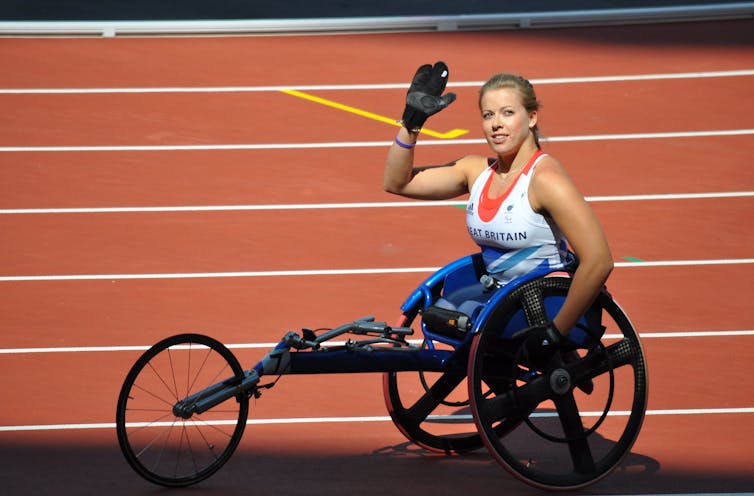The Paralympic Games fails to increase disabled people's participation in sport

Tokyo’s 2020 Paralympics promises to be a sporting spectacle that thrills and excites, showcasing the very best in Paralympic sport. However, looking at the legacy of London 2012 it is unlikely to inspire more people to take part in sports.
Mega sporting events do not automatically increase participation in sport. A systematic review of the evidence found mega sporting events unable to inspire sports participation on their own. Instead, the Paralympic Games and other mega sporting events must be “leveraged”. In other words, organisers and organisations need to strategically supplement the event with planned initiatives encouraging sport participation.
The problem is that hosts often assume the event will bring about increased sport participation but fail to capitalise on the event.
The problem with inspiration is its intangiable quality. How to turn inspiration into habits and concrete change? Trading on inspiration also fails to appreciate wider obstacles and barriers preventing disabled people participating in sport and society.
The London 2012 Olympics and Paralympics represented the first Games to make a concerted effort to achieve a positive sport participation legacy. This makes the London 2012 Games an ideal test case for exploring the viability of increasing disabled people’s sports participation through mega sporting events.

London 2012 Paralympics
One of the main aims of the 2012 Paralympics was to increase the number of disabled people participating in sport. Despite an initial rise in once a week sports participation immediately after the Paralympics (19.1% in 2013), participation subsequently fell back to pre-2012 levels (16.8% in 2016).My PhD research found that the 2012 Paralympics made minimal impact on the number of disabled people participating in sport club settings. Of the 538 voluntary sports clubs that completed a questionnaire about the impact of the London 2012 Paralympics, about six in 10 sport clubs saw no noticeable change in their disabled membership five years after the 2012 Paralympics. Furthermore, about six in 10 sports clubs agreed the 2012 Paralympic Games had no impact on the number of disabled adults participating at their club.
Interviews with 30 individuals from sports and non-sports organisations revealed a complex combination of factors explaining the limited impact. One of the main reasons for the decline in sport participation was the lack of strategic activities and initiatives by sports organisations to maximise the hosting of the Paralympics, as well as a failure to embed a culture of inclusion within sports organisations.
Many sports organisations were unprepared for the level of interest from disabled people and were unable to respond accordingly. For some disabled people, Paralympians lacked relevance. Reduced disposable income caused by austerity was also found to have been an important barrier to participation. Due to negative media portrayals disability, some disabled people were fearful of being active in case they were accused of being a “benefit scrounger” and potentially lose some of their benefits.
While these examples expose the folly of investing faith in a two-week sporting event’s ability to increase sport participation, it’s important to highlight there have been positive developments in disability sport since London’s 2012 Paralympics.
There is increased awareness in the sports sector of the need to provide sporting opportunities for disabled people: disability is an important focus in both the government’s sports strategy and Sport England’s strategy. Funding and research into disability sport has also grown. In the 2013-17 funding round, Sport England invested about £170 million pounds in disability sport, having previously invested significantly less than that.
Most national disability sports organisations gained funding for the first time after the 2012 Paralympics, while 42 national governing bodies of sport received investment for disability, compared to 11 in 2009-13. In 2016, Sport England released its research into disability in England, providing sports organisations with facts about disability.
Despite the positive developments, there are still mountains to climb. Disabled people are still twice as likely to be inactive than non-disabled people.
When you next listen to politicians extolling the benefits of mega sporting events when it comes to boosting participation in sport, be sceptical. It’s likely to be political spin to justify the huge financial investment.
The evidence suggests mega sporting events, on their own, fail to increase sport participation in the long term. Tokyo 2020 hopes to inspire change for disabled people and to make Japan a more accessible society. However, more work needs to be done to make Japan more accessible. If the London 2012 Paralympic Games failed to meaningfully increase sport participation, despite prioritising sport as a legacy goal, what hope is there for Tokyo 2020?
What is the Paralympic Games good for?
The Paralympics is, first and foremost, an elite sports event. Elite sport, by its very nature, discriminates on the basis of ability – only the best is acceptable. It’s questionable whether this is the best way to engage people in sport. There’s no doubt the Paralympics can be inspirational for some people, but its appeal and potency is not for everyone.The Paralympic Games do not represent the diversity of disability and is not a substitute for educating individuals on the lived experience of disabled people. In fact, the Paralympic Games may propagate stereotypical narratives on disability, causing more harm than good. The Paralympics may shine a spotlight on accessibility and inclusion in the host country, but whether this can lead to lasting change is doubtful. For sport participation, the Paralympic Games is not the solution and should be one component of a wider sport participation strategy.
Christopher Brown, Lecturer in Sports Development, University of Hertfordshire
This article is republished from The Conversation under a Creative Commons license. Read the original article.
No comments:
Post a Comment